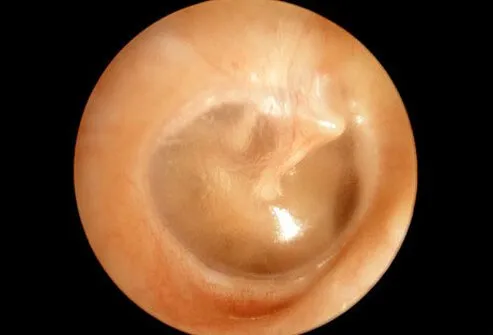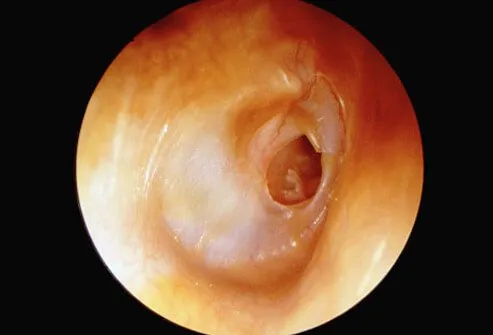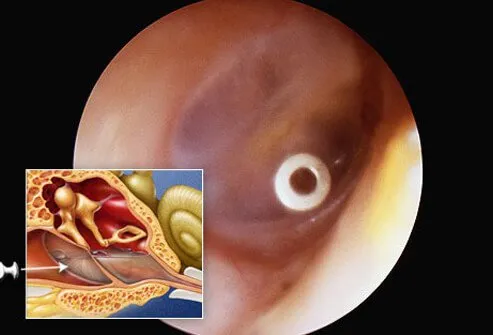Ear Infections

Sometimes it seems like kids are always getting ear infections. Ear infections are very common in children. Children get ear infections about two out of every three times they have a cold. Children are more prone to ear infections because their small ears do not drain fluid as well as adult ears. Kids' immune systems are also immature, and this increases the likelihood of certain infections.
There are three types of ear infections. Each type is defined according to where they occur in the ear canal. An ear infection may take place in the inner, middle, or outer ear. Each type of ear infection may exhibit different symptoms.
Swimmer's Ear (Outer Ear Infection)

An infection of the ear canal (the outer ear) is sometimes referred to as swimmer's ear. The name comes from the fact that it most often occurs when the ear canal stays wet long enough for bacteria or other organisms to grow.
Causes of Swimmer's Ear
The skin lining the ear canal and outer ear offers protection against infections from bacteria and fungi. However, when this skin barrier is broken, bacteria or fungi can invade the ear and cause infection. This ear infection is known as swimmer's ear or an outer ear infection. Swimmer's ear can be caused by too much moisture in the ear canal or from inserting something too deep into the ear.
Swimming or showering causes the acidic environment of the ear canal to be altered, which allows bacteria or fungi to invade the ear. The lining of the ear canal can also be broken by scratching or injuring from cotton swabs or other objects when inserted into the ear. Other causes of swimmer's ear include chemicals that irritate the ear canal and skin conditions that cause the skin to crack.
Swimmer's Ear Symptoms
Swimmer's ear is typically painful. Pain caused by swimmer's ear gradually begins over a day or two. The pain is especially intense when the ear is touched or pulled, or when chewing. Symptoms of swimmer's ear include the following:
- Ear pain or earache (almost always involves only one ear)
- Ear canal itching
- Outer ear redness
- Ear canal swollen shut
- Ear draining fluid or pus (drainage may be clear, white, yellow, or sometimes bloody and foul smelling)
- Fluid crusting at the opening of the ear canal
- Trouble hearing
- Ringing in the ear (tinnitus) and dizziness or spinning sensation (vertigo)
- Feeling of fullness in the ear
- Pain on the side of the face or neck
- Swollen lymph nodes
Swimmer's Ear Treatment: Drops and Home Remedy Options
Treatment for swimmer's ear includes avoiding swimming, over-the-counter pain relievers, and possibly antibiotics. Doctors may prescribe medications that offer symptom relief and clean the affected ear. Home remedies for swimmer's ear include applying heat to the ear with a heating pad and a white vinegar rinse to help restore the ear canal's natural pH and reduce swelling.
Ear Infection Diagnosis

The diagnosis of an ear infection is made by examining the inside of the ear with an instrument called an otoscope. A normal, healthy eardrum has a pinkish-gray color as shown here. The healthy eardrum is clear, while an infected eardrum is bulging (swollen) and reddened. A doctor may also perform a tympanometry, which measures how the eardrum responds to a change of air pressure inside the ear. Hearing tests are also common ways to diagnose an ear infection, especially in children who have fluid in both ears. Blood tests can also be taken if there are signs of immune problems.
Middle Ear Infection

Middle ear infections are caused by bacteria and viruses. Swelling from an upper respiratory infection or allergy can block the Eustachian tubes, which would prevent air from reaching the middle ear. A vacuum and suction then pulls fluid and germs from the nose and throat into the middle ear. Since the tubes are swollen, the fluid cannot drain. This provides a medium for the growth of bacteria or virus, which leads to a middle ear infection.
The otoscope can blow a tiny puff of air against the eardrum to see if it vibrates normally. When there is fluid present in the middle ear, the eardrum does not vibrate normally.
Eustachian Tube
The Eustachian tube is the canal that connects your middle ear to your throat. When the Eustachian tube is open as it is normally, it prevents fluid and air pressure from building up inside the ear. Infections like colds, the flu, or allergic reactions can cause the Eustachian tube to become swollen and blocked.
Middle Ear Infection Symptoms
Symptoms of a middle ear infections tend to occur 2 to 7 days after the start of a cold or other respiratory infection. Middle ear infection symptoms may include:
- Ear pain (mild to severe)
- Fever
- Drainage from the ear that is thick and yellow or bloody
- Loss of appetite, vomiting, and grumpy behavior
- Trouble sleeping
Middle Ear Infection Treatment
Treatment for middle ear infections typically focuses on relieving pain. Over-the-counter pain and fever medications such as acetaminophen and ibuprofen are used. Of note, you should never give aspirin to children. A doctor may prescribe antibiotics for a middle ear infection, but ear infections tend to get better without them. If children have repeat ear infections, a doctor may prescribe long-term oral antibiotic treatment. Inserting ear tubes or removing the adenoids or tonsils may also be a solution for children who have repeat middle ear infections.
Inner Ear Infection (Labyrinthitis)

Labyrinthitis is inflammation inside the inner ear. Labyrinthitis occurs when the labyrinth, a part of the inner ear that helps control your balance, gets swollen. The inflammation of the labyrinth can be caused by respiratory illnesses, viral and bacterial ear infections.
Inner Ear Infection Symptoms
Inner ear infection symptoms begin quickly and can be quite intense for several days. Inner ear infection symptoms include the following:
- Dizziness
- Nausea
- Loss of hearing
- Vertigo (dizziness with the sensation of moving)
- Tinnitus (ringing or buzzing in the ear)
- Difficulty focusing eyes
Inner Ear Infection Treatment
Inner ear infection treatment usually involves medication to control symptoms, such as prescription and over-the-counter antihistamines, sedatives, and corticosteroids. Antibiotics may be prescribed if there is an active infection. The following are various vertigo treatment options:
- Avoid quick change in position or sudden moves
- Sit still during a vertigo attack
- Get up slowly if lying down or seated
- Avoid bright screens or flashing lights during a vertigo attack
- Use low-light rather than darkness or bright lights
Ruptured Eardrum

When the pressure from fluid buildup is too high inside the middle ear, the eardrum can rupture, as shown here. When the eardrum bursts, brown, yellow, or whitish fluid can drain from the ear. Sometimes when the eardrum bursts, the pain suddenly resolves because the pressure is relieved.
Ruptured Eardrum Symptoms
A ruptured eardrum can cause many symptoms. However, the most common symptoms of a ruptured eardrum are an uncomfortable feeling in the ear and the sound of air coming out of the ear when blowing your nose. The following are other symptoms of a ruptured eardrum:
- Sudden sharp ear pain or a sudden decrease in ear pain
- Drainage from the ear that may be bloody, clear, or resemble pus
- Ear noise or buzzing
- Hearing loss that may be partial or complete in the affected ear
- Episodic ear infections
- Facial weakness or dizziness
Ruptured Eardrum Treatment
The eardrum usually heals without medical treatment within a few weeks after a rupture, and hearing is typically not worsened unless rupture and/or infection continues to occur frequently over a period of time. Antibiotics may be prescribed in order to prevent an ear infection. Over-the-counter pain medications may also be suggested if the ruptured eardrum is causing pain. The eardrum may require surgery to repair the rupture. If this is the case, a doctor will attach a piece of your own tissue, usually from above the ear, to the eardrum for reconstruction.
Ear Infection Symptoms

Ear pain is the main sign of ear infection in children. Kids with ear infections may have trouble sleeping because of the pain. Other symptoms include discharge or fluid coming from the ears, fever, problems with hearing, dizziness, or nasal congestion. Symptoms of fluid buildup are:
- Popping, ringing, or a feeling of fullness or pressure in the ear
- Children may rub their ears trying to relieve pressure
- Trouble hearing. Children who have problems hearing may seem dreamy or inattentive, or they may appear grumpy or cranky
- Balance problems and dizziness
Ear Infection Symptoms: Babies

Ear infections aren't always apparent in babies and children who are too young to describe their pain. They may signify ear pain by pulling on or fussing with their ear. They may just be irritable, or not eating or sleeping well. Babies sometimes refuse to drink from a bottle because swallowing hurts their ears. Ear infection symptoms in babies may include:
- Fever
- Ear drainage
- Trouble hearing
- Poor appetite
- Vomiting
- Diarrhea
Ear Infection Home Remedies

There are some home remedies to help your child's ear pain. Ear drops can bring relief, but these should not be used without checking with your child's doctor first. Over-the-counter pain and fever medications such as acetaminophen and ibuprofen are used. However, you should never give aspirin to children. Warm washcloths applied to the outside of the ear may be helpful in reliving some pain. Gargling with salt water may help soothe an aggravated throat and possibly clear the Eustachian tubes. A few drops of warmed olive oil in the ears may soothe ear pain, but it is suggested to speak with your child's doctor beforehand.
Ear Infection Treatment: Antibiotics

Sometimes ear infections resolve without any specific treatment. Some ear infections are caused by viruses, and antibiotics are only effective against bacterial infections, not viral infections. It is possible that your doctor may not want to prescribe antibiotics to start. Your doctor will decide if and when antibiotics should be used.
Ear Infection Complications

Repeated ear infections can lead to scarring of the eardrums. Over time, this can cause hearing and speech problems. Your doctor may recommend having your child's hearing tested if he or she has frequent ear infections. A ruptured eardrum can also be the result of ongoing ear infections. If fluid continues to build up in the middle ear, the eardrum may burst. Chronic suppurative otitis media, chronic inflammation of the middle ear and mastoid cavity, can also develop if there is ongoing inflammation of the middle ear. This condition can cause some hearing loss, but it also can usually be treated with antibiotics.
Ear Infection Treatment: Ear Tubes

Tympanostomy tubes are small tubes that are sometimes inserted in the eardrums of children who have frequent ear infections. This image shows an ear tube positioned in the eardrum. The tubes allow ventilation and drainage of fluid so that fluid cannot buildup in the middle ear. This can lessen the chance of infection and reduce the pain that may be associated with pressure. After surgery, children usually recover within 1 to 2 hours. Ear tubes usually fall out on their own after 6 to 12 months, or a doctor can surgically remove them.
Swollen Tonsils and Ear Infections

Swollen tonsils are not usually a direct cause of ear infections. Enlarged adenoid tissue in the back of the nose can sometimes put pressure on the Eustachian tubes, preventing them from draining fluid out of the ear. However, they are more likely the source of bacteria that causes ear infections. Sometimes, doctors recommend removal for children who have very large adenoids and frequent ear infections.
Are Ear Infections Contagious?

Ear infections are not contagious. However, many children develop ear infections after a cold or other viral infection. Since viral infections are contagious, it is important to do your best to prevent illness. By preventing colds, you're also taking steps to prevent ear infections. Thorough handwashing is the best way to prevent colds. Other preventive measures against infection include avoiding secondhand smoke, receiving the annual seasonal flu vaccine, and breastfeeding babies for at least 6 months to enhance their immune systems.
Do Allergies Cause Ear Infections?

Allergies can cause inflammation and contribute to ear infections by interfering with the Eustachian tube's ability to let air pass into the middle ear. However, in children under two years of age, allergies are usually not the main cause of ear infections. Allergy testing can identify the allergen triggers for your child. Medications or allergy shots usually can bring relief and also lessen the likelihood of ear infections.
Ear Infection Symptoms, Causes, and Treatment
This tool does not provide medical advice. See additional information: 
© 1996-2024 WebMD, LLC. All rights reserved.
